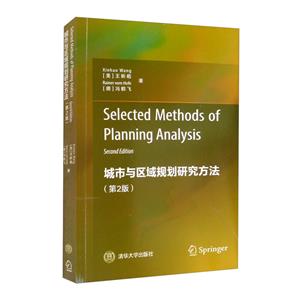-
>
闖進數學世界――探秘歷史名題
-
>
中醫基礎理論
-
>
當代中國政府與政治(新編21世紀公共管理系列教材)
-
>
高校軍事課教程
-
>
思想道德與法治(2021年版)
-
>
毛澤東思想和中國特色社會主義理論體系概論(2021年版)
-
>
中醫內科學·全國中醫藥行業高等教育“十四五”規劃教材
城市與區域規劃研究方法(第2版) 版權信息
- ISBN:9787302591146
- 條形碼:9787302591146 ; 978-7-302-59114-6
- 裝幀:80g膠版紙
- 冊數:暫無
- 重量:暫無
- 所屬分類:>>
城市與區域規劃研究方法(第2版) 本書特色
介紹了規劃及其影響分析的方法,幫助讀者提高收集、分析、和展示數據的能力,掌握如何做、什么時間、在哪里、如何應用適當的方法。
城市與區域規劃研究方法(第2版) 內容簡介
The book aids planners in answering the following cru questions: “Who are they?”, “What do they do?”, “Where do these activities occur?”, "How human activities are connected?”, "What are the economic effects?". In addition to detailed explanations of the selected methods, the book provides a context (scenario analysis) for applying them in performance assessment and impact analysis.
城市與區域規劃研究方法(第2版) 目錄
Acronyms
List of Figures
List of Tables
1 Introduction: Planning Analysis Methods
1.1 Planning
1.2 Planning Analysis
1.3 Structure of the Book
References
2 Demographic Analysis
2.1 Introduction
2.1.1 Typology of Projection Methods
2.2 Demographic Analysis-Fundamental Concepts
2.3 Components of Change-Demographic Reasons for Population Change
2.3.1 Fertility
2.3.2 Mortality
2.3.3 Migration
2.4 Trend Extrapolation Methods
2.4.1 Share of Growth Method
2.4.2 Shift-Share Method
2.4.3 Linear Population Model
2.4.4 Geometric Population Model
2.4.5 Parabolic Population Model
2.4.6 Logistic Population Model
2.5 Cohort-Component Method
2.5.1 The Mortality Component
2.5.2 The Net Migration Component
2.5.3 The Fertility Component
2.5.4 Bringing All Components Together
2.5.5 The Hamilton-Perry Method
2.6 Concluding Remarks
Review Questions
Exercises
References
3 Economic Analysis
3.1 Introduction
3.2 The Economic Base Theory
3.3 Understanding Your Regional Economy
3.4 Assessing the State of a Regional Economy
3.4.1 Compiling a Regional Economic Profile
3.4.2 Preliminary Consideration
3.5 Economic Base Analysis Techniques
3.5.1 The Survey Method
3.5.2 The Assumption Method
3.5.3 The Location Quotient Method
3.6 Evaluating Regional Economies Using the Economic Base Multiplier and Shift-Share Analysis
3.6.1 The Economic Base Multiplier
3.6.2 Shift-Share Analysis
Review Questions
Exercises
References
4 Financial Analysis
4.1 Introduction
4.2 Time Value of Money and Financial Mathematics
4.2.1 Interest Rate (i), Interest, and Compound Interest
4.2.2 Interest Period
4.2.3 Effective Interest Rate
4.2.4 Future Value (FV) for a Single Payment
4.2.5 Future Value (FV) for a Uniform Series of Payments
4.2.6 Present Value (PV) of a Single Future Payment
4.2.7 Present Value (PV) of a Uniform Series of Payments
4.2.8 Ordinary Annuities
4.2.9 More Advanced Financial Calculations
4.3 Net Present Value (NPV) Method
4.4 Internal Rate of Return (IRR) Method
4.5 Equivalent Uniform Annual Cash Flow Method
4.6 Cost-Benefit Analysis (CBA)
4.7 Conclusion.
Review Questions
Further Reading
……
5 Land Use Analysis
6 Transportation Analysis
Index
城市與區域規劃研究方法(第2版) 作者簡介
Dr. Wang is a Professor of Planning in the School of Planning, University of Cincinnati. He holds a Ph.D. in City and Regional Planning from the University of Pennsylvania, a Master of Community Planning from the University of Rhode Island, a Master of Science in Geo-Sciences and a Bachelor of Science in Geography from Peking University, Beijing, China. He teaches courses in Geographic Information Systems (GIS), environmental planning, statistics, and planning research methods.
- >
伯納黛特,你要去哪(2021新版)
- >
詩經-先民的歌唱
- >
伊索寓言-世界文學名著典藏-全譯本
- >
山海經
- >
企鵝口袋書系列·偉大的思想20:論自然選擇(英漢雙語)
- >
【精裝繪本】畫給孩子的中國神話
- >
姑媽的寶刀
- >
中國歷史的瞬間















